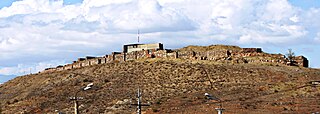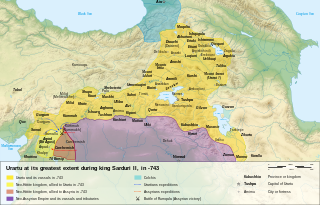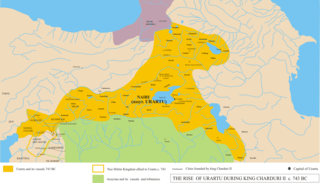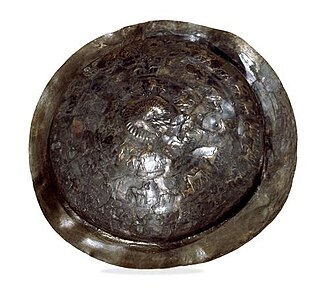| Sarduri III | |
|---|---|
| King of Urartu | |
| Reign | 639–635 BC |
| Predecessor | Rusa II |
| Successor | Erimena |
| Father | Rusa II |
| Mother | Koton |
Sarduri III was a king of Urartu between 639 BC and 635 BC.
Urartian King Argishti II left a record of fourteen years of his reign on the walls of chambers hewn in the Rock of Van, while Sarduri III's victories are inscribed on a monument erected on a spot called "the Treasury Gate" in the fortress of Van. The Urartians had in the east as neighbours the Minni or Manni, in the southerly portion of the Urmiah basin. Records of victories are also found inscribed further north, on the shores of Lake Sevan, at Gyumri and Erzurum.

Tiglath-Pileser III was the king of the Neo-Assyrian Empire from 745 BC to his death in 727. One of the most prominent and historically significant Assyrian kings, Tiglath-Pileser ended a period of Assyrian stagnation, introduced numerous political and military reforms and more than doubled the lands under Assyrian control. Because of the massive expansion and centralization of Assyrian territory and establishment of a standing army, some researchers consider Tiglath-Pileser's reign to mark the true transition of Assyria into an empire. The reforms and methods of control introduced under Tiglath-Pileser laid the groundwork for policies enacted not only by later Assyrian kings but also by later empires for millennia after his death.

Argishti I, was the sixth known king of Urartu, reigning from 786 BC to 764 BC. He founded the citadel of Erebuni in 782 BC, which is the present capital of Armenia, Yerevan. Alternate transliterations of the name include Argishtis, Argisti, Argišti, and Argishtish. Although the name is usually rendered as Argišti, some scholars argue that Argisti is the most likely pronunciation. This is due to the belief that the Urartians used the cuneiform symbol š to voice an s-sound, as opposed to representing the digraph sh.
Rusa I was a King of Urartu. He succeeded his father, king Sarduri II. His name is sometimes transliterated as Rusas or Rusha. He was known to Assyrians as Ursa and possibly Urzana. His birth name may have been Uedipri.

Muṣaṣir, in Urartian Ardini was an ancient city of Urartu, attested in Assyrian sources of the 9th and 8th centuries BC.

Erebuni Fortress is an Urartian fortified city, located in Yerevan, Armenia. It is 1,017 metres (3,337 ft) above sea level. It was one of several fortresses built along the northern Urartian border and was one of the most important political, economic and cultural centers of the vast kingdom. The name Yerevan itself is derived from Erebuni.
Sarduri I, also known as Sarduris, Sedur, and Asiduri, was king of Urartu. He was known as Ishtarduri to the Assyrians.

Argishti II was king of Urartu from 714 BC to 680 BC. He succeeded his father, King Rusa I. During the Urartu-Assyria War, Argishti was responsible for orchestrating major Urartian counter-offensives against the invading Assyrians. His forces drove the Assyrians back across the pre-war border and deep into the Assyrian heartlands, reconquering major towns and cities around Lake Urmia, including Mushashir, Ushnu, and Tepe, and conquering the territory as far south as the city of Nimrud on the Tigris River. These victories forced the Assyrians to accept a lengthy peace and cede large tracts of territory north of the Tigris. The remainder of Argishti's lengthy reign was characterized by a "Golden Age", a period of lengthy peace and economic prosperity, which carried into the reigns of Argishti's two successors, his son Rusa II and his grandson Sarduri III.
Lutipri was the father of the Urartian king Sarduri I.

The Fortress of Van is a massive stone fortification built by the ancient kingdom of Urartu during the 9th to 7th centuries BC, and is the largest example of its kind. It overlooks the ruins of Tushpa, the ancient Urartian capital during the 9th century, which was centered upon the steep-sided bluff where the fortress now sits. A number of similar fortifications were built throughout the Urartian kingdom, usually cut into hillsides and outcrops in places where modern-day Armenia, Turkey and Iran meet. Successive groups such as the Medes, Achaemenids, Armenians, Parthians, Romans, Sassanid Persians, Byzantines, Arabs, Seljuks, Safavids, Afsharids, Ottomans and Russians each controlled the fortress at one time or another. The ancient fortress is located just west of Van and east of Lake Van in the Van Province of Turkey.

Tushpa was the 9th-century BC capital of Urartu, later becoming known as Van which is derived from Biainili, the native name of Urartu. The ancient ruins are located just west of Van and east of Lake Van in the Van Province of Turkey. In 2016 it was inscribed in the Tentative list of World Heritage Sites in Turkey.
Shubria or Shupria was a kingdom in the southern Armenian highlands, known from Assyrian sources in the first half of the 1st millennium BC. It was located north of the upper Tigris River and to the southwest of Lake Van, extending eastwards to the frontiers of Urartu. It appears in the 1st millennium BC as an independent kingdom, succeeding the people earlier called Shubaru in Assyrian sources in the later centuries of the 2nd millennium BC. It was located between the powerful states of Assyria and Urartu and came into conflict with both. It was conquered by Assyria in 673–672 BC but likely regained its independence towards the end of the 7th century BC with the collapse of Assyrian power.
Arzashkun or Arṣashkun was the capital of the early kingdom of Urartu in the 9th century BC, before Sarduri I moved it to Tushpa in 832 BC. Arzashkun had double walls and towers, but was captured by Shalmaneser III in the 850s BC.

Sarduri II was a King of Urartu, succeeding his father Argishti I to the throne. The Urartian Kingdom was at its peak during his reign, campaigning successfully against several neighbouring powers, including Assyria.

The Urartu–Assyria War was a conflict between the Kingdom of Urartu and the Neo-Assyrian Empire. The war began around 714 BC, with the invasion of Urartu by the Assyrian King Sargon II. Sargon led multiple offensives deep into Urartian territory, amassing numerous victories in the war. Following his death, however, Urartian Kings Argishti II and Rusa II launched many successful counterattacks, reclaiming Urartu's lost territory and gaining some from Assyria. However, their successors suffered multiple major defeats, resulting in Urartu becoming an Assyrian client state.

The Urartu was an Iron Age kingdom centered around the Armenian highlands between Lake Van, Lake Urmia, and Lake Sevan. The territory of the ancient kingdom of Urartu extended over the modern frontiers of Turkey, Iran, Iraq, and the Republic of Armenia. Its kings left behind cuneiform inscriptions in the Urartian language, a member of the Hurro-Urartian language family. Since its re-discovery in the 19th century, Urartu, which is commonly believed to have been at least partially Armenian-speaking, has played a significant role in Armenian nationalism.

Sardurihinilli, also known as Haykaberd or Çavuştepe Kalesi, is an ancient Urartian fortified site located on a ridge on the northeastern edge of the village of Çavuştepe in the Gürpınar district of Van Province in eastern Turkey. It is located approximately 25 kilometers southeast of Van along the road leading to the city of Hakkâri, in a valley once known as Hayots Dzor in historic Armenia. It was founded by the Urartian king Sarduri II some time during his reign in the 8th century BC and is believed to be identical with the fortress of Sardurihurda mentioned in the same king's cuneiform inscriptions.
The economy of Urartu refers to the principles of management of Urartu, the ancient state of Western Asia which existed from the thirteenth to the sixth century BC. It peaked around the eighth century BC but was destroyed with the fall of the state about a century later. The economy of Urartu was typical of ancient Oriental Despotism and was closely associated with that of neighboring Assyria.

Erimena, according to tradition, was the twelfth king of Urartu and reigned from 625 to 605 BC. He was the successor of Sarduri III and father of Rusa III, who ruled Urartu from 610-590 B.C. Little is known about Erimena; his name was mentioned in an inscribed bronze shield found at Toprakkale by Hormuzd Rassam in 1880 that is now located in the British Museum. Erimena, according to a Babylonian chronicle, held an expedition in the mountainous region of Bit Hanounia, under the rule of Nabopolassar. He also suffered many attacks from the Babylonians which led to the decline of Urartu.
The Battle of Kummuh marked the end of the Urartu hold on northern Syria, as Tiglath-pileser III defeated Sarduri II in 742 B.C.